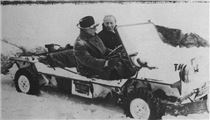Twin-Engine Mini Beats Snow
8 January 1963
From Our Motoring Correspondent
LONGBRIDGE. BIRMINGHAM, JAN. 7 1963
A twin-engined 1696cc version of the BMC Mini-Car has been produced experimentally at the BMC works here by Mr Alec Issigonis, technical director, and Mr George Harriman, chairman of BMC.
Together they have been working on special versions of the vehicle for nine months, with the idea of conquering arctic driving conditions and last Thursday it passed its final proving runs. The vehicle-known as the twin-engined Moke 4x4-is powered by two 848cc Mini engines fitted front and rear and driving each pair of wheels which use the normal independent rubber suspension. The car with an open body, has interconnected throttles and clutch controls. But there are two rear levers mounted on either side of the driver so that with the front engine in use the rear engine and drive can be brought in when required.
In snow 1ft deep I drove the double-engined Moke today at up to 40mph. Starting in normal first gear we ploughed through the snow, changing up to second and bringing in the rear engine with a flick of the off-side gear lever. Snow flew up on either side in 6ft plumes but the Moke roared forward with complete traction, carrying eight bales of hay. When a 4ft snowdrift brought the car to a halt we put both engines into reverse and cleared the drift in three seconds. Acceleration was as fast and positive as on a dry road and the car can cope easily with a one-in-two gradient. The twin Moke has a power output of 72bhp a top speed of 75mph, and double the pulling power of the standard Mini. It is designed basically as an agricultural and military cross-country vehicle.
In production form-not subject to purchase tax - it would cost about £475 (against £672 for the Land-Rover). Or, as a double- engined saloon, it could be produced for £850. Mr Harriman told me: 'This was originally conceived by Mr Issigonis and myself from the idea of an 0-8-0 locomotive, which has its wheels linked on either side. After producing some experimental versions we found that the traction of the two Mini engines balanced each other and that it was possible to run one in top gear and the other in bottom simultaneously.'
The power output can be stepped up by 1100cc power units to 110bhp and the designers say that it could be easily adapted to use an electronic gear change.
More news from the archive
Compare classic car insurance quotes and buy online. A friendly service offering access to a range of policies and benefits.





